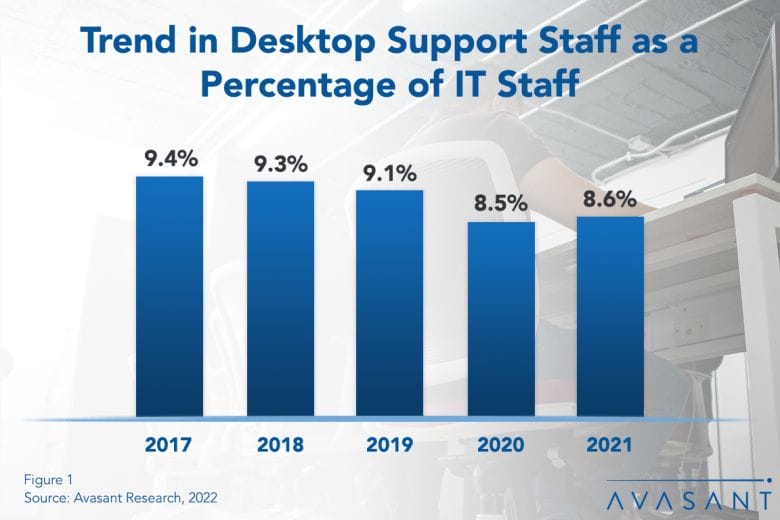Although desktop and laptop computers are not the hot commodity they were 30 years, they still require a great deal of support. The good news, however, is that when viewed as a percentage of the total IT staff, desktop support personnel are becoming steadily more productive.
As shown in Figure 1 from our full report, Desktop Support Staffing Ratios, the desktop support staffing levels across all organization sizes ticked up to 8.6% at the median in 2021, which is up just slightly from 8.5% in 2020. Still, when viewed over five years, this ratio has been on a slow and steady decline—or, to put it in a positive light, it takes fewer support personnel to maintain the desktop/laptop inventory.

Over the past many years, desktop support technicians are now handling many PC issues remotely, reducing the need for on-site staff at every remote office. Moreover, software-as-a-service (SaaS) applications shift some of the support burden to the software vendor. Finally, the latest version of Microsoft Windows, which still runs on the majority of desktop and laptops, is more reliable and easier to maintain than previous versions.
“As companies continue to shift toward remote and hybrid work, it’s a good thing that remote desktop support tools have become so good,” said Reneece Sterling, research analyst for Computer Economics, a
service of Avasant Research, based in Los Angeles. “You can’t have PC support technicians making house calls.”
The term “desktop support” requires definition. In some organizations, desktop support refers to personnel who are present on-site to help users with PCs, laptops, network connectivity, telephones, and often other equipment. Other organizations consider desktop support as a Level II help desk function. Still other organizations have distinct help desk and desktop support groups, each with multiple tiers.
Desktop support refers to all technical support activities related to user systems, including desktop computers, laptops, mobile devices, and workstations of all types. In most companies, these include activities such as building or setting up new machines, initial installation of operating systems and standard application software, applying periodic updates and security patches, replacing and disposing of obsolete equipment, monitoring usage, and responding to user-reported incidents. In many cases, desktop support personnel also may support printers, LANs, digital whiteboards, telephones, conference room projectors/displays, point-of-sale systems, or other end-user equipment. We include all of these functions within the scope of desktop support—an antiquated term that nevertheless is still widely used.
Our full report provides benchmarks on typical desktop support staffing. We use four metrics to benchmark desktop support staffing: desktop support staff as a percentage of the IT staff, PCs per desktop support staff member, applications per desktop support staff member, and users per desktop support staff member. We also assess these ratios by organization size and sector. In addition, we provide benchmarks for organizations with combined desktop support, help desk, and IT training/documentation functions. We conclude with strategies for improving the efficiency of desktop support staff.
This Research Byte is a brief overview of our report on this subject, Desktop Support Staffing Ratios. The full report is available at no charge for subscribers, or it may be purchased by non-clients directly from our website.(click for pricing).




